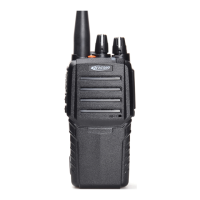The radio will make an alert tone in advance before the TOT terminates the transmission. After
the alert tone, when the time of transmission exceeds the preset time, the TOT timer will act.
3) TOT Rekey Time
A period in which the radio is forbidden to transmit after its overtime activity.
During the period, if the PTT button is pressed, an alert tone will be sounded, and the
transmission is forbidden.
4) TOT Reset Time
The time delay from releasing the PTT button to the resetting of the timer is limited.
The countdown will go on if the time after releasing the PTT key is shorter than the reset time.
7.2 Busy Channel Lockout (BCL)
If the channel on which a user attempts to transmit is being used by another party, BCL
function restricts the transmission in order to avoid interfering with the other parties'
communication, and the radio will make an alert tone, and returns to the receiving state.
7.3 Battery Saving
The battery saving function can reduce power consumption of the radio when no signal is
received and no operation is conducted (no button is pressed and no knob is turned).
If the radio hasn't receive any signal or no operation is being conducted for 16 seconds, the
radio will enter Battery Saving Mode. When a signal is received or any operation occurs, the radio
will exit the Battery Saving Mode automatically.
7.4 Low Battery Warning
When the battery voltage drops too low while transmitting, the LED flashes red, low battery
warning tone sounds, and the radio stops transmitting. You need to recharge or change the battery.
7.5 Monitor
When there is no signal received, the radio's squelch circuit will mute the speaker
automatically so that the background noise will not be heard by the user. You can press and hold
the preprogrammed Monitor button to open squelch manually. This function is especially useful
when you need to adjust the volume level or to receive weak signals.
When the Monitor button is pressed and held, the LED indicator lights green, and the radio is
in the monitoring state.
7.6 CTCSS/DCS
CTCSS/DCS tones may have been pre-programmed on some radio channels. A CTCSS/DCS
tone is a sub-audible tone, which allows you to ignore (not hear) calls from other irrelevant parties
who are using the same channel. When you receive a signal that has a tone different from the one
set on your radio, you will not hear the signal. Likewise, signals that you transmit will only be
received by parties whose CTCSS/DCS tones are the same as yours.
Note: Using a CTCSS/DCS channel doesn’t mean your calls are private. If other parties’
CTCSS/DCS tones are identical with yours, they can hear your calls.

